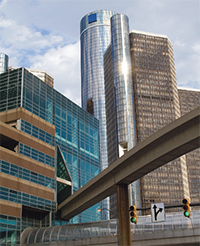Restarting Motor City

More and more people want to live downtown. To get them to move there, cities are taking an active role in downtown redevelopment.
A perfect example is Detroit, which is in the midst of a major renaissance, according to Katharine Czarnecki, director of community development at the Michigan Economic Development Corp. (MEDC), a state organization whose mission includes urban and community development. The transformation here is astounding, explains Czarnecki, who says redevelopment in two Detroit neighborhoods, in particular Downtown and Midtown, where the residential vacancy rate is just 2 percent has catalyzed a citywide revitalization effort. [Downtown buyers] want walkability, a range of housing options, culture and recreational activities. Were trying to leverage all those things to move the needle forward.
Demand alone isnt enough to make urban cores thrive. To transform downtowns from blighted to booming, cities must follow Detroits lead by taking a 360-degree approach that includes:
Development: To grease the wheels for redevelopment, MEDC has a program known as Redevelopment Ready Communities®, whereby it helps local governments encourage redevelopment by increasing transparency and streamlining the development process.
Recreation: Its not enough to give people places to live. You also must give them things to do, according to Czarnecki, who says Detroit has begun offering free entertainment for example, live music, movies and art exhibitions at city parks in the summer.
Public spaces: Every vibrant city has dynamic public spaces, whether its Central Park in New York, Boston Common in Boston or Millennium Park in Chicago. With that in mind, MEDC recently launched a campaign that will give matching funds to community groups that raise money with crowdfunding to help them infuse Michigan cities including Detroit with more green space.
Safety: Because Detroits negative reputation hampers downtown growth, law enforcement, government and businesses are collaborating to fight crime and improve safety, Czarnecki says.
Transportation: People who live downtown demand affordable, convenient public transportation. In July 2014, Detroit therefore commenced work on the M-1 RAIL streetcar, a 3.3-mile circulating streetcar in downtown Detroit that eventually will be part of a larger public transportation system.
Concludes Czarnecki, If youre going to encourage people to live downtown, you need to understand that theres more to the city than just working and living. You have to take a holistic approach to urban development, and Detroit is a very good example of that.







